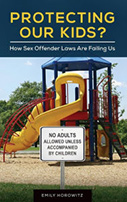Protecting Our Kids? How Sex Offender Laws Are Failing Us

Author: Emily Horowitz
Publisher: Santa Barbara, CA: Praeger, 2015. 181p.
Reviewers: David Patrick Connor and Tia Michelle Squires | May 2016
The American moral panic surrounding sex offenders has arguably stemmed from public outcry about rare, heinous, and overly publicized attacks on young children, and resulted in well-intentioned (but flawed) efforts to address sexual predation and child abuse. Using this arousal of social concern over sexual lawbreakers as a backdrop,Protecting Our Kids? How Sex Offender Laws Are Failing Us attempts to tease apart fantasy from reality. Horowitz carefully weaves two distinct narratives throughout the text to do this. The first narrative focuses on the origins of sex offenders as demons, monsters, and undesirables. As a sociologist, Horowitz successfully explains how perpetrators of sex offenses came to be known as inhumanly cruel and wicked, by analyzing cultural, historical, political, and social contexts surrounding laws and policies aimed at them. The second and perhaps more interesting narrative centers on the contemporary experiences of publicly labeled sex offenders and their family members.
Through six chapters (with additional introductory and conclusion sections), Horowitz sets out to establish what she sees as the realities of sex offender legislation. A macro-level analysis of the historical contexts behind sex offender laws and policies in the United States, and a micro-level examination of the attitudes, beliefs, and perceptions of publicly identified sex offenders and their loved ones serve as the primary evidence for her arguments. These two competing lenses allow readers to simultaneously understand the motivations that spurred the creation and implementation of sex offender legislation, and to appreciate the experiences of people who must deal with the corresponding consequences in America today — while recognizing the often counterproductive and unnecessarily harsh nature of such laws and policies.
In the first chapter, Horowitz works to build a chronological timeline of the development of sex offender legislation in the United States. She goes back to 1962 when C. Henry Kempe introduced the labeled concept of child abuse to America. Horowitz effectively demonstrates the direct impact of Kempe’s ideas by showing how states subsequently adopted sex offender laws and policies between 1963 and 1967 in an attempt to stop child abuse. Unfortunately, as she illustrates, such laws largely ignored more common forms of child neglect and maltreatment. By 1973, only 10 years after the idea of child abuse was firmly established in the minds of Americans, Horowitz notes that the United States Congress enacted the Child Abuse Prevention and Treatment Act (CAPTA). As a result of the CAPTA, she convincingly argues that the stage was set for sex offenders to be regarded as social pariahs, despite the law’s expressed goal of providing protection to society’s youth.
Horowitz, later in the same chapter, describes several individuals who have direct experiences with sex offender legislation in order to shed light on the extreme nature of the current laws and policies. Here, she introduces readers to some convicted sex offenders or their family members who provide little support for the idea that sex offenders are monstrous creatures in need of constant supervision. At the same time, the qualitative data suggest that strategies to control convicted sex offenders often negatively impact individuals who voluntarily interact with and support them in the community. To be sure, Horowitz largely gives accounts of convicted sex offenders who find themselves in circumstances that are likely to be viewed as the exceptions rather than the rules. Thus, among readers such offenders may garner more sympathy, be more well received than other sex offenders, and serve as more compelling examples.
In addition, Horowitz discusses the testimony of Jolly K., the founder of Parents Anonymous, who admitted to and testified to Congress about physically abusing her daughter. The congressional hearings were held prior to the passage of the CAPTA. By utilizing Jolly K.’s testimony to illustrate the value of the CAPTA, Horowitz convincingly contends that Congress (and a majority of society) saw child abuse as an American social problem, and as an individual illness that was curable through therapy, rather than as criminal behavior that needed to be punished. The relevance of this discussion is powerfully crafted in the text by questioning whether or not sex offenders testifying to their sex offenses before Congress would yield the same type of support that a physically abusive mother received. Horowitz correctly, we think, asserts that the answer is “no” – a sex offender would not be seen as a model citizen capable of self-help – and the moral panic surrounding sex offenders would only be perpetuated as a result. Indeed, by labeling individuals who sexually abuse as categorically different from individuals who otherwise abuse, the myths that sex offenders are incurable and very likely to reoffend are solidified in the minds of the public.
The framework and comparisons that Horowitz makes in the first chapter are vital for setting the tone that continues in the remaining portions of the book. She uses this approach to dispel the common misconceptions surrounding sex offenders. These widely held but false beliefs include notions that sex offenders are a unique breed that can never be cured; are primarily violent strangers preying on young children in public places; and are mostly older men who victimize young children. Horowitz effectively presents the empirical reality to combat these myths. She points out that sex offenders have lower recidivism rates than almost all other groups of criminals; that sex offender treatment is often successful; that over 95% of sex offenses are committed by first time offenders; and, that children commit a large number of sex offenses against other children.
In the second chapter, as if qualitative narratives were not persuasive enough, Horowitz highlights numerous quantitative studies to effectively demonstrate the relationships between race, poverty, and child abuse. Interestingly, she observes that poorer families, in comparison to wealthier families, experience rates of abuse that are three times higher, and rates of neglect that are seven times higher. Horowitz acknowledges that poverty alone is not responsible for child abuse and neglect, but that socioeconomic status is important to consider when examining other factors that may contribute to child abuse and neglect. Moreover, she views race as inextricably linked to poverty and other social inequalities, and it is thus asserted to be salient to child abuse and neglect. Horowitz raises many valuable questions throughout this chapter, as she attempts to understand why “normal,” everyday abuses of children go largely unnoticed, when in fact abused and neglected children endure those effects throughout their lives.
The buildup of the moral panic that presently surrounds sex offenders is explained in the third and fourth chapters. Here, Horowitz considers at length the phenomena that fueled harsh attitudes, beliefs, and strategies toward sex offenders, including stranger danger, daycare panic, and Operation Halloween Zero Tolerance. It is refreshing to read her reporting of events, as it is quite balanced and fair. Numerous offenses by sex offenders who were strangers to their victims are described as extremely heinous acts that paved the way for moral panic and ill-conceived laws and policies. She notes that victims’ parents understandably used the media with the purpose of finding their missing children, but inadvertently spread misconceptions about sex offenders as a whole that led to nationwide concern, distress, and trepidation.
In the fifth and sixth chapters, case studies are used to make arguments regarding the utility of sex offender legislation. One case study examines statewide sex offense convictions before and after the implementation of a sex offender registration and notification (SORN) statute in New York. Horowitz finds that the public identification of sex offenders did little to deter future sex offenses, as most of these offenses were committed by first time offenders. As a result, she asserts that subjecting sex offenders to public labeling does not protect children and only serves the purpose of punishment. Here she is echoing other studies that have raised serious doubts about the deterrent impact of SORN.
The conclusion section is appropriately entitled “Why We Need to Talk About Sex Offenders.” The author’s main contention is that critical discourse regarding criminal justice laws and policies aimed at sex offenders is important and needed, as it will allow for reform and better ways to tackle the problems of sexual predation and child abuse. However, as she wisely points out, American society demonizes individuals and groups who speak out against norms and current approaches to sex offender management, which ultimately prevents open and honest conversations about not only flawed laws and policies, but also about abuses suffered by children. The book serves as one example of a growing body of literature that challenges widespread notions about, and responses to, sex offenders, through frank discussions based on scholarly investigations.
Ultimately, Emily Horowitz has crafted an engaging and empirically supported text that features powerful stories of human failures, mistakes, and suffering that stimulate the mind and provoke reflection on the purpose, effectiveness, and consequences of laws and policies aimed at convicted sex offenders in the United States. Although the flow and organization of the chapters make following her arguments difficult at times, she paints an important picture regarding sex offender legislation and the plight of abused children, of the abusers, and of the individuals closest to them.
David Patrick Connor, Assistant Professor, Department of Criminal Justice, Seattle University
Tia Michelle Squires, Graduate Student, Department of Criminal Justice, Seattle University


